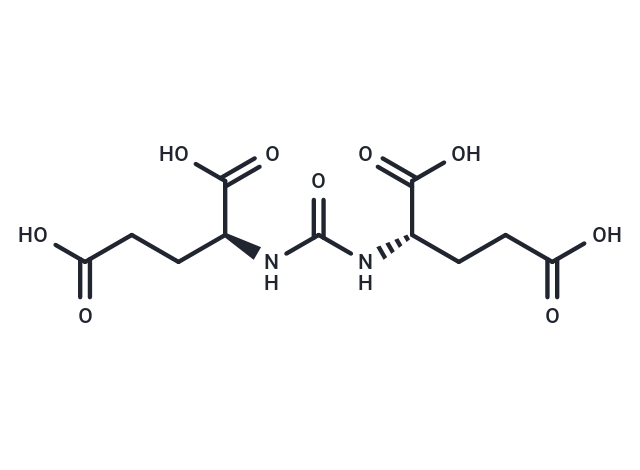Shopping Cart
- Remove All
 Your shopping cart is currently empty
Your shopping cart is currently empty

DUPA (N,N''-Carbonylbis[L-glutamic acid]) is used as the targeting moiety to actively deliver DTX for treatment of Prostate-Specific Membrane Antigen (PSMA) expressing prostate cancer.

| Pack Size | Price | Availability | Quantity |
|---|---|---|---|
| 2 mg | $37 | In Stock | |
| 5 mg | $59 | In Stock | |
| 10 mg | $97 | In Stock | |
| 25 mg | $176 | In Stock | |
| 50 mg | $297 | In Stock | |
| 100 mg | $455 | In Stock | |
| 200 mg | $657 | In Stock | |
| 500 mg | $987 | In Stock |
| Description | DUPA (N,N''-Carbonylbis[L-glutamic acid]) is used as the targeting moiety to actively deliver DTX for treatment of Prostate-Specific Membrane Antigen (PSMA) expressing prostate cancer. |
| In vitro | DUPA is utilized as a targeting moiety to actively deliver Docetaxel (DTX) for treating prostate-specific membrane antigen (PSMA)-expressing prostate cancer. |
| In vivo | As determined by loss of body weight and death of treated mice,DUPA-indenoisoquinoline conjugate induces a complete cessation of tumor growth with no toxicity[2]. |
| Alias | N,N''-Carbonylbis[L-glutamic acid], (2S,2'S)-2,2'-Carbonylbis(Azanediyl)Dipentanedioic Acid |
| Molecular Weight | 320.25 |
| Formula | C11H16N2O9 |
| Cas No. | 302941-52-2 |
| Smiles | [C@H](NC(N[C@@H](CCC(O)=O)C(O)=O)=O)(CCC(O)=O)C(O)=O |
| Relative Density. | no data available |
| Storage | Powder: -20°C for 3 years | In solvent: -80°C for 1 year | Shipping with blue ice. | |||||||||||||||||||||||||||||||||||
| Solubility Information | DMSO: 280 mg/mL (874.32 mM) H2O: 140 mg/mL (437.16 mM) | |||||||||||||||||||||||||||||||||||
Solution Preparation Table | ||||||||||||||||||||||||||||||||||||
H2O/DMSO
| ||||||||||||||||||||||||||||||||||||

Copyright © 2015-2024 TargetMol Chemicals Inc. All Rights Reserved.